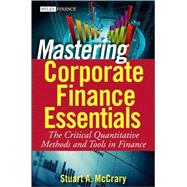
Note: Supplemental materials are not guaranteed with Rental or Used book purchases.
Purchase Benefits
Acknowledgments.
Chapter 1 Time Value of Money Toolbox.
Introduction.
Cash Flows.
Future Value.
The Impact of Compounding Frequency on Future Value.
Equivalent Interest Rate.
Continuously Compounded Interest.
Present Value.
Formulas for Present Value and Future Value.
Conclusion.
Questions.
Chapter 2 Statistics for Finance.
Introduction.
The Meaning of Mean or Average.
Median as a Substitute for Mean.
Standard Deviation Measures the Noise.
Annualizing Variance and Standard Deviation Estimates.
The Normal Curve Is a Probability Distribution.
The Cumulative Density Function.
Measures of Dependency.
Measuring Covariance and Correlation.
Calculating Statistics in Practice.
Combining Normal Distributions.
Conclusion.
Questions.
Chapter 3 Core Finance Theories and the Cost of Capital.
Introduction.
Risk Reduction from Diversification.
Systematic versus Unsystematic Risk.
The Market Portfolio.
The Capital Asset Pricing Model.
Using Beta to Determine the Required Return for a Stock.
Other Factor Models.
Cost of Debt.
Weighted Average Cost of Capital.
Modigliani and Miller.
Patterns of Debt and Equity in Capital Structures.
Conclusion.
Questions.
Chapter 4 Capital Budgeting Tools.
Introduction.
Three Ways to Evaluate Investments.
Calculating Net Present Value.
Net Present Value Example.
Calculating Internal Rate of Return.
Calculating Years to Payback.
Financial Decision Making.
The Annuity Formula.
Valuing an Annuity with More Frequent Cash Flows.
Using the Present Value Formula and the Annuity Formula to Value a Bond.
Using the Annuity Formula to Value a Mortgage.
NPV Using the Annuity Formula.
Valuing a Perpetuity.
Valuing a Growth Annuity.
Introduction to Uncertainty.
Conclusion.
Questions.
Chapter 5 Techniques for Handling Uncertainty.
Introduction.
Using Scenario Analysis.
Using Monte Carlo Simulation.
Uniform Random Numbers.
Transforming Uniform Distributions.
Adding and Multiplying Two Random Numbers.
Using Random Numbers in a Budget Analysis.
Using Random Numbers in a Capital Budgeting Analysis
Conclusion.
Questions.
Chapter 6 Real Options Analysis of Capital Investments.
Introduction.
Why Study Options?
What Is a Real Option?
Types of Real Options.
Methods for Valuing Real Options
Conclusion
Questions.
Appendix: Day Counting for Interest Rate Calculations.
Introduction.
The 30/360 Method
The Actual/Actual Method.
The Actual/360 Method.
The Actual/365 Method.
Example and Comparison of 30/360 and Actual/Actual.
Impact of Day Counting over Longer Intervals.
Calculating Calendar Intervals over Long Periods.
A Note about Continuous Compounding.
Conclusion.
Questions and Answers.
About the Author.
Index.
The New copy of this book will include any supplemental materials advertised. Please check the title of the book to determine if it should include any access cards, study guides, lab manuals, CDs, etc.
The Used, Rental and eBook copies of this book are not guaranteed to include any supplemental materials. Typically, only the book itself is included. This is true even if the title states it includes any access cards, study guides, lab manuals, CDs, etc.